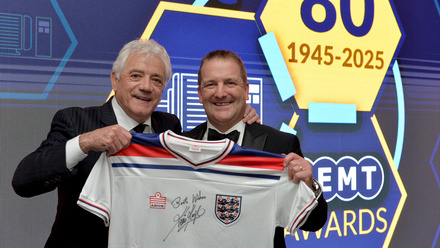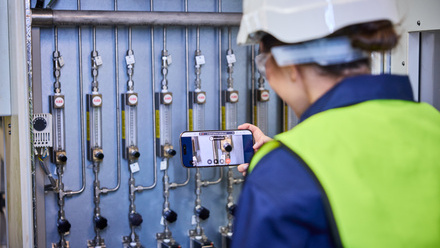Glossary of Engineering Terms
Aa | Bb | Cc | Dd | Ee | Ff | Gg | Hh | Ii | Ll | Mm | Nn | Pp | Rr | Ss | Tt | Uu | Vv | Ww | Yy
Aa
Actuator: A device that creates mechanical motion by converting various forms of energy to rotating or linear mechanical energy.
Active power (P): Real power in an AC circuit measured in Watts (W).
Adjustable Speed Drive: Output speed of drive can be selected from several preset ranges.
Aging: The reduction of insulation life due to thermal, voltage and other stress.
Air Gap: Short gap in the magnetic material forming a magnetic circuit.
Alternator: Electromechanical device that converts mechanical energy to electrical energy in the form of alternating current.
Ambient Temperature: Temperature of the air in the immediate vicinity of the apparatus or component.
Amortisseur Winding: Embedded windings in the field poles of synchronous machines to aid starting and / or dampen rotor oscillations.
Ampere (A): SI base unit of electric current.
Apparent Power (S): Measured in volt-amperes (VA) in an AC circuit.
Armature: The part of a machine which receives or delivers active power to the external electrical system.
Asynchronous Machine: An AC machine in which the speed on load and the frequency of the system to which it is connected are not in a constant ratio.
American Wire Gauge: Standardised wire gauge system used predominantly in the USA.
TopBb
Brush: A sliding electrical contact, usually rotating.
TopCc
Capacitance: The amount of electrical energy stored for a given electric potential.
Chord or Pitch Factor (kp): The factor by which short pitching a coil reduces the back e.m.f.
Cogging Torque: Magnetic interaction between stator and rotor resulting in undesired machine operation such as jerkiness.
Coil: Set of series connected turns.
Coil Pitch or Span: The number of tooth pitches which separate the slots in which the two sides of a coil are placed.
Commutation: Change-over switching in a periodic and automatic manner without interruption of the electric current.
Commutator: An assembly of insulated conducting segments connected to the rotating armature winding.
Concentric Winding: A distributed winding in which the individual coils of each phase group per pole are concentric and have different coil spans.
Conductor: A material which contains movable electrical charges.
Core Loss: The electrical losses in a machine caused by the magnetisation of the core iron.
Critical Speed: The rotating speed at which resonance occurs.
TopDd
Delta Connection: The 3 phases are connected in series to form a closed circuit.
Direct Current Machine: A machine incorporating an armature winding connected via a commutator to a direct current system.
Distribution Factor (kd): Ratio of the actual voltage of a phase band to the arithmetic sum of the individual coil voltages.
Dhalander Connection: Pole-changing winding giving a rotational speed ratio of 2:1.
Duplex winding: An armature winding in which the coil ends are connected to alternate commutator segments.
Duty Cycle: Specified sequence of operating conditions.
TopEe
Eddy Currents: Localised magnetically induced currents in an iron core.
Efficiency: Ratio of output power to input power of a device.
Electromotive Force: The force induced in a conductor when it is moved across a magnetic field. (e.m.f.)
Exciter: A source of the power to the field winding of an electrical machine.
TopFf
Foot-Pound (energy): The energy transferred on applying a force of 1 pound-force (lbf) through a displacement of 1 foot.
Foot-Pound (torque): The torque created by one pond-force (lbf) acting at a perpendicular distance of one foot from a pivot point.
Form Wound Coil: Coil of square or rectangular insulated magnet wire preformed to fit into winding slots.
Form Factor: Ratio of the root-mean-square value of an alternating quantity to its rectified value.
TopGg
Generator: Rotating electric machine used to transform mechanical energy into electric energy.
TopHh
Harmonic Content: Difference between alternating quantity and its fundamental component.
Hermetic Machine: Air-tight machine protected from the environment.
Hertz (Hz): SI derived unit for frequency defined as the number of cycles per second of a periodic function.
Horsepower (hp): Unit of power. 1hp = 746W
TopIi
Impedance: The ratio of the voltage to the electric current, a measure of opposition to time-varying electric current in an electric circuit.
Inductance: Property in an electric circuit where a change in the current induces an electromotive force that opposes the change in current.
Induction Motor: An AC motor where power is supplied to the rotor by magnetic induction.
Induction Generator: An induction machine, connected to a reactive power source, working as a generator.
Insulation: The materials and parts used to insulate conductive elements of a machine.
Insulation Class: Temperature capability of insulation materials and systems.
Inverter: Converter that changes direct electric current to single-phase or poly-phase alternating currents.
TopLl
Lap Winding: Armature winding with each coil of 2 conductors placed in slots 90° apart, connections made in adjacent segments of a commutator.
Leakage Current: Electric current in an unwanted conductive path.
Loop Test: Test to detect hot spots due to shorted electrical laminations.
TopMm
Magnetic Flux Density: Strength of a magnetic field.
Magnetomotive Force (m.m.f.): Physical force that produces magnetic flux.
Motor: A machine which converts electrical energy into mechanical energy.
Mush Coil: A wound coil where the conductors occupy random positions in the slot.
TopNn
Newton: Force required to accelerate a mass of one kilogram at a rate of one meter per second per second.
TopPp
PAM winding: Pole Amplitude Modulation winding with connections giving speed combinations other than 2:1.
Part Winding Start: Starting with only part of the winding energised to reduce starting current.
Phase Voltage: Voltage between the two terminals of a phase.
Poles: Magnetic poles created in a machine by windings.
Pole Pitch: The distance between two consecutive poles; usually expressed as a number of tooth pitches.
Power: The rate at which work is performed.
Power Factor: Ratio of the absolute value of the active power P to the apparent power S.
TopRr
Random Wound Coil: The conductors occupy random positions in the slot.
Rated Temperature Rise: The permitted rise in operating temperature above ambient when running on load.
Reactance: The resistance to AC current due to capacitance or inductance.
Reactive Power (Q): Measured in var in an AC circuit.
Regeneration: Operation of a motor in a generator mode to feed energy back into the power supply.
Regulation: Amount of speed or voltage change due to load variations.
Reluctance: The ‘resistance’ of a magnetic circuit.
Resistance: Defined as the ratio of voltage to current.
Rotor: The rotating part of an electrical machine.
TopSs
Salient Pole: A field pole which projects from the yoke or hub towards the air-gap.
Secondary Winding: A winding in an electrical machine which is not connected to the external electrical system.
Series Excitation: DC machine with field coils connected in series with the armature.
Service Factor: The factor by which the rated power can be increased under specified conditions of service.
Shaft Currents: Induced circulating currents due to machine asymmetries or supply voltage effects.
Shunt Excitation: DC machine with field coils connected in parallel with the armature.
Skew: Non parallel stator and rotor slot alignment.
Slip : The difference between the synchronous speed and the actual speed of a rotor expressed as per unit or as a percentage of the synchronous speed.
Slot: A recess in a core in which the conductors of a winding may be placed.
Squirrel Cage: Rotor winding consisting of a number of conducting bars with their ends connected by conducting rings.
Space Factor: The ratio of the area of bare insulated copper conductors to the available slot area.
Star Delta Starting: A delta wound motor connected in star during starting to reduce inrush current.
Synchronous Machine: An AC machine in which the frequency of the generated voltages and the speed of the machine are in a constant ratio.
Full load Speed: Machine speed at rated load.
Synchronous Speed: The speed of magnetic field rotation determined by the supply frequency and the number of poles.
Stator: The stationary portion of a machine.
TopTt
Tolerance: Permitted deviation between the declared value of a quantity and the measured value.
Torque: The rotational force produced by a motor.
- Breakdown Torque: Maximum torque an AC motor will develop.
- Full Load Torque: The torque the rated load demands on the shaft end of a motor.
- Starting Torque The torque produced by a motor at initial switch on.
Uu
Unbalanced Magnetic Pull: Unequal radial pull on a rotor due to magnetic eccentricities in the air gap.
TopVv
Variable Speed Drive (VSD): System for altering the rotational speed of an AC motor by controlling the frequency of the electrical supply.
Volt (V): Derived SI unit for electromotive force (e.m.f.)
TopWw
Watt (W): SI unit of power.
Wave Winding: Armature winding with each coil of 2 conductors placed in slots 90° apart, connections made in segments approximately 180° apart on the commutator.
Winding Factor: The product of the Pitch Factor and the Distribution Factor. (kp x kd)
TopYy
Yoke: Part of a device, composed of magnetic material and intended to complete a magnetic circuit.
Top



